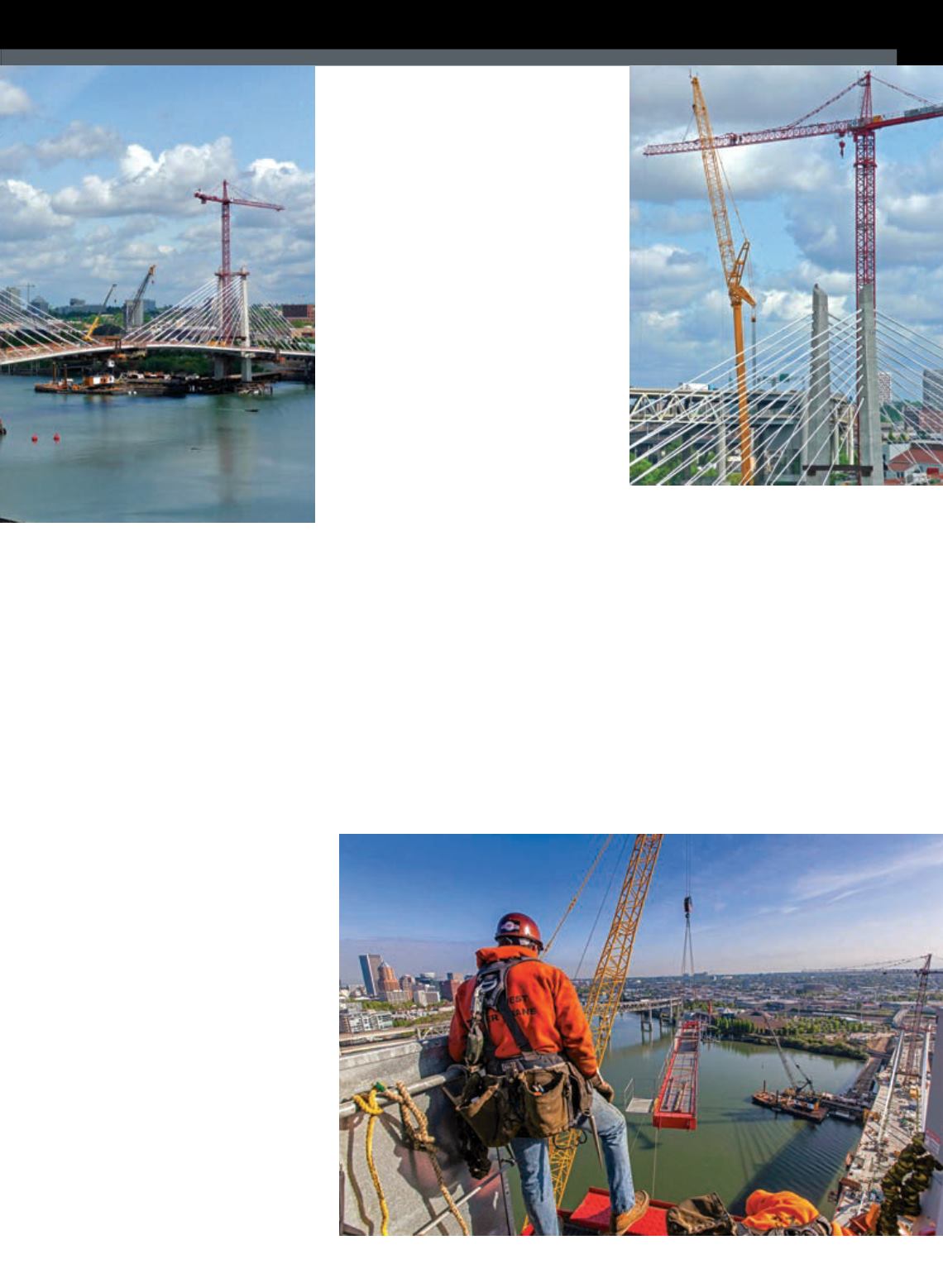
41
NOVEMBER 2014
ACT
LIFTING
SITEREPORT
tonLTM1500-8.1 is soversatile,”he said.
“Thehardpartwas the small amount of
real estatewehad to assemble the crane.”
The cranewas riggedwith amainboom
of 155 feet and a luffing jibof 138 feet.
“Theplatformwas barelybig enough
for themachine to fit onwidthwise,”
Chapman explained. “Theplatformwas
about 50 feetwide and about 200 feet
longbut it had a turn in themiddleof it
so therewasn’t a straight shot down the
ramp.Whatwedidwas install theboom
withour boom launch trailer in the lay-
down yard, and thenwewalked the crane
down the ramp to theworking surface
and assembled it inplace.”
For thewestern crane, it took aday to
move the crane in and assemble it and
then aday to takedown the first tower
crane.
For the second crane, itwas decided to
set up the 600-tonLiebherr on thedeckof
thebridge from the east.
“Wehad tohit certainmarks on the
bridge tomake surewedidn’t exceed
the capacityof thedeck andnot cause
damage to the surface,” saidChapman.
“Theoutriggers had tobeprecisely in a
certainplace.”
While the cranewas rigged the same
way itwaswith the first tower crane
take-down, Chapman said theway the
componentswerebrought downwas
different.
“For this one, wehad towork in
between cable stays andwehad even less
real estate toworkwith,”he said. “When
wewerebringing thematerial out of the
To take down the first tower crane, the
600-ton Liebherr all-terrain cranewas
positioned on awork platform about 20
feet below the bridge deck.
The heaviest component
was about 32,000 pounds.
Height wasn’t an issue because the
600-ton Liebherr LTM 1500-8.1 is so
versatile, according to ProjectManager
Bill Chapman, Ness and Campbell
Cranes. Themost difficult part was the
small amount of real estate available to
assemble the crane. The Liebherr ATwas
riggedwith amain boom of 155 feet and
a luffing jib of 138 feet.
air to the ground to loadon trucks, we
had tobe especially careful. Thisminimal
amount of space slowed things down
a lot. Itwas verypoignant cranework
andwehad tomake surewe kept the
paint colors off eachother. Redmaterials
comingdownon awhitebridge and
everyonewouldknow it.”
The second crane camedown in two
days due tohowmuch time it took to
maneuver thematerials down. Aswell,
they couldonlybring inone truck at a
time to load the components on, which
caused additional timedelays.
“Therewas a lot of anticipation and
excitement toget this onedown andget it
behindus,” saidChapman. “We knewwe
coulddo it anddo so safely.”
Chapman said thatwhilehis company is
often calledon to takedown tower cranes,
this particular job requiredmuchmore
research and engineering than the average
tower crane take-down.
“This job requiredour doing the
research andmaking sure the customer
was comfortablewith the information
wewere giving them,”he said. “The
success of this jobdependedonmaking
sure everyonewas informedof theplan,
and especially the craneoperator and
oilers. This planhadbeengoneover and
purified, and if therewere anydeviances,
theyhad tobe communicated and that
communicationhad tobe kept open.”
Of the crane, Chapman said the
Liebherr LTM1500-8.1was an ideal
choice.
“It’s a versatile cranebecause you can
useminimal counterweight tokeep the
ground-bearingpressuredownbut you
still have a lot of reach, which iswhatwas
required.
Chapman said that also critical to the
success of this jobwere the expert skills
of theoiler, Shaun Julian, and the crane
operator,DrewCasey.
■


